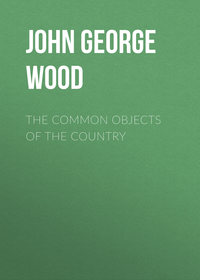 полная версия
полная версияNature's Teachings
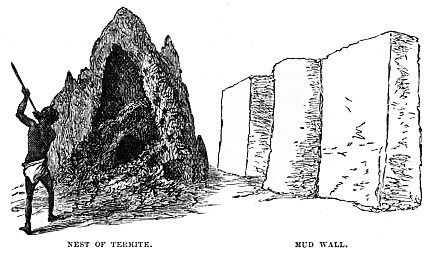
If the builders are in any way fastidious, they make their walls of a uniform surface by placing two rows of planks on their edges at a distance from each other proportionate to the thickness of the wall, pouring the mud between them, and, when it has sufficiently hardened, shifting the planks. This, however, is not necessary, and detracts much from the picturesque look of a genuine mud wall, especially when it is of that rich red which characterizes the Devonshire soil. These mud walls are locally known by the name of Cob.
We have not to go very far in Nature to find good examples of the strength which can be attained by mud walls.
In all parts of the world where Termites, popularly but wrongly called White Ants, are to be found, the strength and endurance of the mud wall can easily be tested. Of gigantic dimensions when compared with the size of the architect, they not only endure the rain-torrents which wash over them, but can sustain the weight of the wild cattle, which are in the habit of using them as watch-towers, and this although they are hollow, and filled with chambers and galleries.
In Southern Africa these nests are much utilised. There is an animal called by the Dutch settlers the Aard-vark, which feeds almost wholly on Termites. At night it issues from its burrow, and, being armed with large and powerful claws, tears a great hole in the side, and devours the inmates.
These deserted nests are sometimes used as ovens, as we have already seen, a fire having been kindled within them for some time, the meat, well enveloped in leaves, being thrust into them, and the opening closed with clay. Sometimes they are used as graves, the corpse being placed in them, and the hollow filled up with earth, while the wall of the Termite nest, when pounded and mixed with water, is found to be the most tenacious clay that can be used for building or flooring huts.
Porches, Eaves, and WindowsWe now come to some of the appendages of a house, namely, the Porch by which the rain is kept from a doorway, the Eaves by which it is kept from the walls, and the Windows which will admit light and air, but will prevent the entrance of intruders.
We first take the Porch, two examples of which are shown in the accompanying illustration, one being the work of human hands, and the other that of an insect.
The figure on the right hand represents an old-fashioned Porch, such as is often to be seen attached to old village churches, and which, being furnished with seats, serves also as a resting-place for those who are weary.
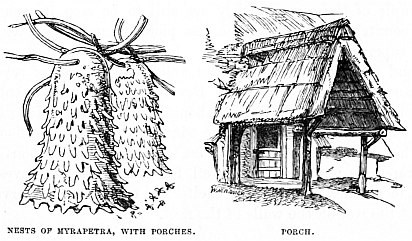
The figure on the left hand of the illustration is a wonderful example of the Porch, as constructed by insects. It is the nest of a honey-making Brazilian wasp named Myrapetra scutellaris. The peculiarity of this nest consists in its exterior being covered with a vast number of projections made of the same material as the walls of the nest, but more solid and much harder. The colour of the nest is blackish brown.
The object of all these projections has not been ascertained, but there is no difficulty as regards some of them. Without a very careful examination, it is exceedingly difficult to see any opening by which the inhabitants of the nest can go in and out. It will be found, however, that there are many entrances, which are set in a row round the nest, each opening being situated under a projection, which thus performs the office of a porch as well as that of concealment.
Another hymenopterous insect carries out the principle of the Porch in its nest. This is the Myrmica Kirbyi, a tiny reddish Ant which inhabits India. It makes its nest of cow-dung, which it works up into a texture very like that of an ordinary wasp-nest. A series of large flakes of this substance overhang the entrances, so that the inhabitants can enter freely, while rain is kept out. For the purpose of greater security, one very large flake covers the roof in umbrella fashion. The whole nest is globular, and about eight inches in diameter.
Next we come to the projecting Eaves, like those of our houses, and serving to preserve the body of the edifice itself from wet. On the right hand of the illustration there is an example of the eaves as they are still to be seen in some of our country places, where the less picturesque slates have not yet superseded the old thatch. In some places these eaves extend considerably beyond the walls, and I know of several instances, especially in North Devon, where a supplementary set of eaves extends, like a penthouse, throughout the length of the building, and just above the windows of the ground-floor.
The reader will remark that the projections upon the Myrapetra’s nest may very well fulfil the office of eaves as that of porches, and not only shelter the entrances, but serve to shoot the wet off the walls of the nest.
On the left hand of the illustration are several instances of eaves as existing in Nature.
In the centre is the compound nest of the Sociable Weaver-bird of Southern Africa (Philetœrus socius).
This is a dwelling constructed very much after the fashion adopted by many hymenopterous insects, namely, that each pair of birds make their own individual nest, but unite with their companions in constructing a common roof or covering. More than three hundred nests have been found in a single habitation, and sometimes the birds miscalculate, or rather, do not calculate the resisting power of the branches, and, when the rainy season comes, the additional weight of water brings down the whole edifice with a great crash.
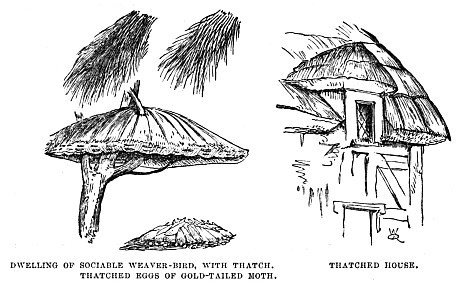
The thatch which covers this congeries of nests is made of the Booschmannees-grass, whose long leaves and tough wiry stems are admirably adapted for throwing off water, even though they be not bound together like our more regularly constructed thatch.
Perhaps the reader may be aware that in the Orang-outan, the Chimpansee, and other large apes, the hairs of the arms are very long, and point in different directions, so that if the creature should be caught in a rain-storm, and, after the manner of its kind, fold its arms on its breast, with the hands resting on the shoulders, the rain is shot clear of its body, the hairs performing the duty of eaves.
Both Japan and China have a rain-cloak, constructed on exactly the same principle as the thatch of the Sociable Weaver-bird. They are nothing more than successive rows of long grass-blades fastened to a network of the proper shape. No amount of rain or snow can wet them through, and they have the advantage of being pervious to the exhalations of the body, though impervious to external moisture.
In this respect they are greatly superior to our waterproof coats, for, if the wearer has to undergo much bodily exertion, or is obliged to wear it for any length of time, he finds his clothing nearly if not quite as wet as if he had allowed the pure rain to fall on him from the clouds. I possess specimens of each kind of cloak.
When I procured them they were quite blackened with London smoke, and, on account of their resistance to water, washing them was a very long and troublesome business.
Above the nest are two patches of the Booschmannees-grass, as they appear when laid by the bird.
Below the nest is a group of the eggs of the Gold-tailed Moth, whose nest has already been described. Perhaps the reader wonders where the eggs are. Owing to the mode in which they are arranged, only a few can be seen, and are represented by the little white spots in the lower part of the figure. When the Gold-tailed Moth is ready for the great business of laying her eggs, she seeks a suitable place, and then piles them up in the form of a shallow cone. Her task, however, is not yet finished. Having arranged her eggs, she scrapes off the long downy hairs of the tail-tuft, and arranges them carefully on the eggs so as to cover them with a conical thatch, very much resembling that of an ordinary corn-rick.
The Brown-tailed Moth acts in a similar fashion.
Furs of various kinds act in the same manner, being impervious to wet during the life of the animal. Such, for example, is the fur of the Beaver, that of the Capybara, and that of the Seal, which are animals living in our time. These, however, are exceeded in their thatch-like powers by the three successive coatings of hair that were worn by the ancient Mammoth, the outermost being very long and very coarse, and hanging down in heavy tufts so as to shoot the water from them.
Being on the subject of roofs, we will take a few more examples of the roof as anticipated in Nature.
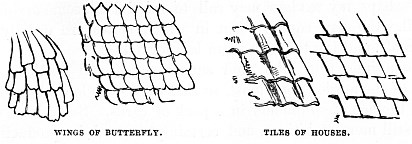
That parallel fibres, whether animal or vegetable, can throw off rain when properly arranged, has already been shown. Much more is it evident that flat or partly flat plates will have the same effect, if they be arranged so that the joints are “broken,” as masons and bricklayers say, i.e. so that the broad part of the upper row of plates overlaps the junction of two of the plates in the row immediately below it.
On the right hand of the accompanying illustration are given two sketches of a modern roof, one slated and the other tiled. The figures on the left show that this formation has been anticipated by Nature, in the wonderful system of scales which cover the wings of butterflies and moths, and to which all their brilliancy of colour is owing. In spite of their minute size, most being too small to be distinguished by the unaided eye, they are arranged as regularly as the best workman could lay the slates or tiles on a roof, and on exactly the same principle.
The shapes of these scales vary in almost every species, but they are always arranged on the same plan, namely, being placed in successive rows, each overlapping the other.
In consequence, it is almost impossible to wet a butterfly’s wing with water. The insect may be plunged beneath the surface, and the long hairs of the body will be soaked and cling together in a very miserable fashion. But the water rolls off the wings like rain off a slated roof, and even if a few drops remain on the surface, they can be shaken off, and the wing will be perfectly dry.
Mostly these scales are flat, but sometimes they are curved. I have among my microscopic objects a piece of wing from a South American butterfly, the scales of which are oblong and bent, just like the curved tiles shown in the second right-hand figure of the illustration. These beautiful scales are deep azure or warm brown, according to the direction of the light.
Perhaps my readers may call to mind that some architects dislike the flat, square form in which slates are usually put on roofs, and try to make them less formal.
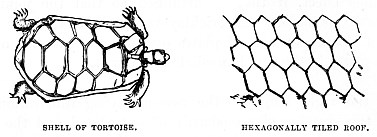
Sometimes they take their square slates, and fit them with one of the angles uppermost, so that each slate looks something like the ace of diamonds in a pack of cards. Sometimes they are still more ambitious, and certainly succeed in producing a better effect, by cutting the slates in hexagons instead of squares, and fixing them as shown in the right-hand figure of the illustration. Putting aside the familiar hexagons of the honeycomb, and the apparent hexagons of an insect’s compound eye, we have in the common Tortoise an example of hexagonal plates that exactly resembles the slate roofing.
In the next illustration we have a variety of the same principle exhibited in differently shaped tiles and scales. The figures on the right hand show the pointed, the square, and the oblong tiles. These also would answer very well as representations of different forms of scale armour, the one being intended to throw off rain, and the other to repel weapons.
On the other side of the illustration are examples taken from the animal kingdom. First comes the Bajjerkeit, or Short-tailed Manis, which has already been mentioned, and whose imbricated scales will resist the blows of any spear or sword. As to my own specimen, when it is struck, it resounds as if it were a solid plate of metal, and I should think that during the lifetime of the animal a reasonably strong axe would not easily make its way through that coat of mail.
Below the Manis are a pair of fish, whose scales, though not so strong as those of the mammal, yet are arranged in the same manner, and answer the same purpose. The last figure represents three scale-bands of the Armadillo, an animal which has already been mentioned. I may as well state here that in several anthropological museums there are various portions of defensive armour made from the scale-clad skin of the Crocodile, Manis, and similar animals.
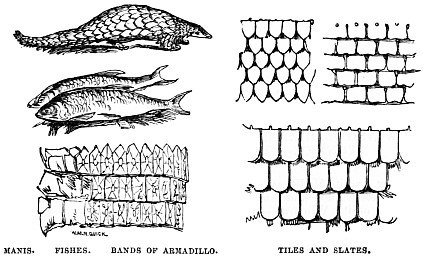
CHAPTER III.
THE WINDOW.—GIRDERS, TIES, AND BUTTRESSES.—THE TUNNEL.—THE SUSPENSION-BRIDGE
The Window, and its Modifications according to Climate.—Bars and Tracery.—The Wheel-window and the Caddis.—Curious Structure of the Caddis-tube.—Object of its Window.—The Girder as applied to Architecture.—The Radius and Ulna.—The Tie as applied to Architecture, and its Value.—Combination of the Tie and Girder.—Structure of the Crystal Palace.—Leaf of the Victoria Regia.—A Gardener turned Architect.—The Buttress in Art and Nature.—The Tunnel used as a Passage of Communication.—Natural Tunnel of the Ship-worm.—The Thames Tunnel.—The Piddock, or Pholas.—The Driver-ant.—The Suspension-bridge.—The Palm-wine Maker and his Bridge.—Suspension-bridges of Borneo and South America.—The Creepers and the Monkey Tribes.—The Spider and Little Ermine Caterpillar.
The WindowHAVING traced, though but superficially, the chief parts of a building, such as the walls, the door which is opened through the walls, and the roof which shelters them, we naturally come to the Windows by which light is admitted to them, and enemies excluded.
There are, perhaps, few points in Architecture in which such changes have been made as in the Window, which, instead of being a difficulty in the way of the architect, is now valued as a means of increasing the beauty of the building. Taking for example even such advanced specimens of Architecture as those furnished by Egypt, Greece, and Rome, we find that the Window is either absent altogether, its place being supplied by a hole in the roof, or that, when it is present, it was made quite subordinate to the pillars and similar ornaments of the building.
This fact is, perhaps, greatly owing to the influence of climate. In the parts of the world which have been mentioned in connection with this subject, light and heat appear to be rather enemies than friends, and the object of the architect was to enable the inhabitants of his houses to avoid rather than to welcome both. Consequently, the Windows were comparatively insignificant. They were not needed for the purposes of light or air, those being generally furnished by the aperture in the roof, and consequently were kept out of sight as much as possible.
But when architects had to build for a sterner, a colder, and a darker clime, where the sun never assumed that almost devouring heat and light which in hot countries drive the inhabitants to invent endless devices for obtaining coolness and shade, a different style of Architecture sprang up. In this the Window became nearly the most prominent part of the building: the elements were excluded by glass instead of stone, and the principal modifications of light were obtained by staining the glass in various rich colours. Perhaps the Window has attained its culminating point in the Crystal Palace, which is all window except its foundations.
Partly in order to enable the glass to be inserted, and partly to increase the beauty of the building, and to avoid the mean appearance of Windows filled in with plain iron bars crossing each other at right angles, the interior of the Windows was adorned with stone “tracery,” varying much according to the epoch of the building.
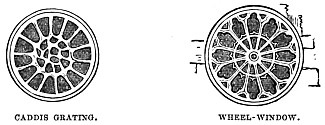
One of the most beautiful forms of the Window is that which is called the Wheel. The window itself is circular, and the tracery is disposed so as to bear an exact resemblance to an ornamental wheel, the lines of the tracery running from the circumference to the centre, just like the spokes of a wheel. One of these Wheel-windows is shown on the right hand of the illustration.
On the other side is an object, which at a hasty glance might be taken for another Window of the same character. It is, however, the work of an insect, and not of man, and is magnified in order to show its structure better.
Any of my readers who may happen to be entomologists or anglers, or both, are familiar with the Caddis-worm of our fresh waters. Most of us know that the Caddis is the grub or larva of the Stone-fly (Phryganea), an insect haunting the waterside, and so moth-like in its general aspect that many persons think that it is really a brown moth. The changes or metamorphoses of these insects are well worthy of notice.
In one respect the Caddis resembles the larva of the Wax-moth, mentioned on page 151, inasmuch as it has a soft, defenceless body, while the first three segments are comparatively hard. Like the Wax-moth also, the Caddis lives in a tube constructed by itself. Instead, however, of having a long and fixed tube, up and down which it can pass at pleasure, the Caddis makes a tube only a little longer than its body, and light enough to be carried about, just as the hermit-crab carries its supplementary shell. There are many species of Caddis-fly.
The Caddis inhabits fresh waters, and cares nothing whether they be ponds or running streams. In order to defend its white, plump, and helpless body from the fishes and other enemies, it constructs a tube around its body, strengthening it by a wonderful variety of material according to the locality.
Mostly the tubes are covered with little pieces of stick or grass, or leaves, while some species use nothing but sand-grains, constructing with them a tube very much resembling in shape an elephant’s tusk, and reminding the conchologist of the dentalium shell. But they seem to use almost anything that comes to hand. Taking only examples found by myself in a single pond, these cases are formed of sand, stones, sticks, grass-stems, leaves, shells of small water-snails, mostly the flat planorbis, the opercula of the water-snail, empty mussel-shells, a chrysalis of some moth which had evidently been blown into the water from an overhanging tree, and acorn-cups. The larva, however, does not seem to be able to fasten together any objects with smooth surfaces, and though it has been known, when in captivity, to make its cases out of gold-dust or broken glass, it could not use either material when in the form of beads.
When it is full-fed, and about to enter the pupal state, it proceeds to prepare its habitation. As a larva, when it desired to feed, it protruded its head and the front of its body from the mouth of the tube, and then crawled about in search of nourishment, dragging the tube with it, and holding it firmly by means of the claspers with which the end of the body is furnished. But when it becomes a pupa it is no longer able to defend itself, and is instinctively compelled to secure its safety in some peculiar manner.
It cannot fasten up the entrance entirely, because it would not be able to breathe unless water could pass over its body. Accordingly, it constructs a grated window precisely like those of the old castles, so that water can pass freely, while no enemy can gain admittance. Unlike, however, the grated windows of the castle, which had no pretence to beauty, the Caddis always constructs its barriers in some definite pattern. Each species appears to have its own peculiar pattern, but all agree in making their window, if we may so call it, exactly like a wheel-window before the glass is inserted.
When the pupa is about to make its final change into the perfect form, it cuts away the tracery with a pair of sharp jaws, with which it is furnished for this sole purpose, emerges from the water, throws off the pupa-skin, and issues forth as a Stone-fly.
Girders, Ties, and ButtressesNext in order come the means by which walls are supported internally by Girders and Ties, and externally by Buttresses.
Of late years the Girder, in its many varieties, has come into general use, especially in the construction of railway bridges and similar edifices.

On the right of the accompanying illustration is shown the Girder in its simplest form. The figure was taken from a Girder which is used in supporting the walls of a large building in Bermondsey. Sometimes a transverse stay connects the centres of the two curved beams; but it is seldom needed.
The reader will see that if the interval between the curved beams were to be filled up, we should obtain a form very like that of the engine beam described in page 25; while, if we could imagine two such girders intersecting each other at right angles throughout their length, a section of the two would exactly resemble the section of the engine beam as given in the uppermost figure in page 25.
In the human body there are four admirable examples of the natural Girder, namely, in the bones of the arms and legs.
On the left hand of the illustration are shown the two bones of the fore-arm, technically named the “radius” and “ulna.” It will be seen that these bones are arranged on the principle of the girder. In men who are especially powerful of grasp, it has been noticed that the curve of the radius and ulna has been exceptionally bold, while we have it developed to the greatest extent in the fore-arm of the Gorilla, an animal whose arms are simply gigantic.
The two bones of the legs, from the knee to the ankle, are arranged in a similar manner, and are called the “tibia” and “fibula.” The last named signifies a brooch, and is given to the bone because it is very slender, nearly straight, and when in its place bears no small resemblance to the pin of the fibula, or ancient Roman brooch.
Nature, however, has exceeded Art in her girder. Those of man’s manufacture can only exert their strength in one direction, and would be of little use if force were to be applied to them in any other direction. Those of the human body, however, have the capability of partial revolution on each other at their points of junction, thus enabling the Girder to apportion its strength according to the direction of the resistance which it has to overcome.
We now come to the Ties, i.e. those internal beams, whether of metal, wood, stone, or brick, which prevent walls from falling outwards. There is no danger of the walls falling inward, but there is very great danger of their falling outward, especially when the weight or “thrust” of the roof tends to force them apart.
In some buildings, such as an old country church which I attended for many years, the architect had openly acknowledged the tendency of the walls to fall outward, and had counteracted it by a series of great beams extending completely across the nave and aisle. As he had not even troubled himself to hide their office, so he did not trouble himself to conceal the fact that they were tree-trunks, but left them roughly squared with the axe, lest, if he had squared them throughout their length, he should have diminished their strength.
The effect of the partially squared beam is, of course, far more picturesque than that of a completely squared one. The architect, however, need not have been so careful about strength, for if the beams had been only half their diameter they would have been just as effective. The strain on them is by pulling, and not by pushing. Now, as any one can see by trying the experiment with a splinter of wood—say a lucifer-match—an enormous power is required to break it by tearing the ends asunder, while it can be easily broken by pushing them towards each other.
But for this power of resistance, we should never have had our Crystal Palace. That apparently intricate, but really simple (and the more beautiful for its simplicity), intersection of beams and lines diminishing in the distance to the thickness of spiders’ webs, is nothing more than a combination of the Girder and Tie, the two together combining lightness and strength in a marvellous manner.




